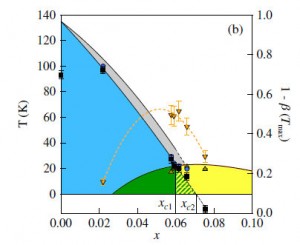Cluster Spin Glass and Superconductivity in Iron-Arsenides
Postdoc Adam Dioguardi’s work on the iron-based superconductors has recently appeared in Physical Review Letters (Coexistence of Cluster Spin Glass and Superconductivity in BaFe_{1-x}Co_{x})_{2} for 0.060 < x < 0.071).

When this material is doped with sufficient cobalt, the ground state evolves from antiferromagnetic to superconducting; however for intermediate doping levels the electronic system appears to become an inhomogeneous mixture of these two states. When the Neel temperature (onset of antiferromagnetism) is lower than the superconducting temperature, the Fe spins freeze out, but do not exhibit long range order. Rather, there appear to be regions of different sizes of coupled spins. There is a clear connection between these clusters of frozen Fe spins and superconductivity, but at present there is no understanding of the microscopic topology of these two types of orders. Curiously, similar phenomena have been observed in the high temperature superconducting cuprate families. However, the mechanism responsible in the cuprates, traditionally interpreted in terms of charge inhomogeneity, cannot be responsible in this iron-pnictide system.
